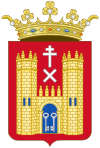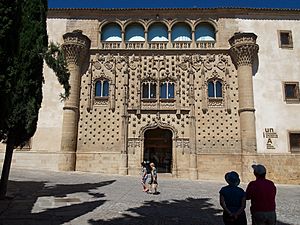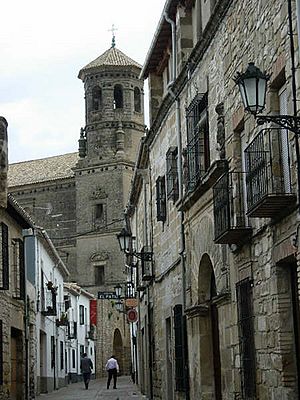Baeza, Spain facts for kids
Quick facts for kids
Baeza
|
|||
|---|---|---|---|

Skyline, with the Cathedral at the centre.
|
|||
|
|||
| Country | Spain | ||
| Autonomous community | Andalusia | ||
| Province | Jaén | ||
| Area | |||
| • Total | 194.3 km2 (75.0 sq mi) | ||
| Elevation | 769 m (2,523 ft) | ||
| Population
(2018)
|
|||
| • Total | 15,902 | ||
| • Density | 81.843/km2 (211.97/sq mi) | ||
| Demonym(s) | Baezanos | ||
| Time zone | UTC+1 (CET) | ||
| • Summer (DST) | UTC+2 (CEST) | ||
| Postal code |
23440
|
||
| UNESCO World Heritage Site | |||
| Part of | Renaissance Monumental Ensembles of Úbeda and Baeza | ||
| Criteria | Cultural: (ii), (iv) | ||
| Inscription | 2003 (27th Session) | ||
| Area | 4.8 ha (12 acres) | ||
| Buffer zone | 176 ha (430 acres) | ||
Baeza is a beautiful city and town in Spain. It's located in the province of Jaén, which is part of the Andalusia region. It's part of a region called La Loma.
Its name has changed over time. The Romans called it Vivatia, the Visigoths called it Biatia, and the Moors called it Bayyasa.
Today, Baeza is famous for its amazing buildings. Many of them show the beautiful Italian Renaissance style. Along with the nearby city of Úbeda, Baeza was added to UNESCO's list of World Heritage Sites in 2003. This means these cities have special cultural importance.
Contents
Exploring Baeza's Location
Baeza is located on a high cliff. This cliff is part of a mountain range called the Loma de Úbeda. To the south, you'll find the Guadalquivir River, and to the north, the Guadalimar river.
A Look at Baeza's Past
Early Beginnings and Roman Times
Baeza is an old city with a long history. During the time of the Roman Empire, it was known as 'Beatia'. Later, when the Visigoths ruled, it became an important religious center.
Moorish Rule and Christian Reconquest
From the 8th century, the city was ruled by different Arab and Berber states. They called it Bayyasa. In 1227, Ferdinand III of Castile took back the city for the Christians. This was after a big battle called the Battle of Las Navas de Tolosa.
When the Christians took over, many Muslim people had to leave Baeza. This changed the city's population and culture.
Baeza in the Middle Ages
For many years, Baeza was one of the most important cities in the Kingdom of Jaén. Other important cities included Jaén, Úbeda, and Andújar.
Farmers in Baeza grew mostly cereal crops. They also grew grapevines, olive trees, and almond trees.
The Golden Age of Baeza
The 16th century was a very special time for Baeza. It became rich from different businesses, especially making cloth. Important families in the city hired famous architects, like Andrés de Vandelvira. These architects designed the beautiful cathedral, churches, and palaces you can still see today.
The city's university building was built in 1533. However, Baeza became less important in the 17th century. This actually helped preserve its old buildings, as not many new ones were built. The university closed for a while but reopened later as a seminary. By the late 1800s, the city's population grew as a railway was built nearby.
Famous Landmarks to See
Baeza has many beautiful and historic buildings. Here are some of the most important ones:
- Natividad de Nuestra Señora Cathedral: This grand cathedral has a mix of old Gothic and Renaissance styles. It was finished in the 16th century by famous architects like Andrés de Vandelvira.
- Town Hall (Ayuntamiento): This building was originally a courthouse and a prison. It has a special style called Plateresque.
- Baeza University: Founded in 1533, this building is now a secondary school.
- Santa Cruz Church: This is a very old Romanesque church. It even has an arch from the Visigothic period.
- St Paul's Church: A Gothic church with a beautiful Renaissance entrance. It also holds the tomb of Pablo de Olavide.
- The Chapel of St Francis: This is part of the ruins of an old monastery building from 1538.
- Jabalquinto Palace (Palacio de Jabalquinto): This palace has a stunning Gothic entrance and a beautiful Renaissance courtyard.
- Spain Plaza (Plaza de España): A lovely public square in the city.
- Constitution Plaza (Plaza de la Constitucíon): This plaza features a marble fountain with Caryatides (statues of women used as columns).
- St Mary Fountain (1564): A historic fountain.
- The Fountain of the Lions: This fountain comes from the ancient Roman ruins of Cástulo. It might represent Himilce, the wife of the famous general Hannibal.
- The Úbeda Gate and Jaén Gate: These are old city gates.
- The Villalar Arch (Arco de Villalar): This arch was built to honor Charles V's victory in 1521.
- Seminary oratorio of St Philip Neri (1660): A religious building.
Getting Around Baeza
Baeza is about 327 km (203 miles) south of Madrid by highway. The nearest train station, Linares–Baeza, is about 15 km (9 miles) away. You can also take buses to cities like Granada, Málaga, and Madrid. The closest international airports are in Granada and Málaga.
Famous People from Baeza
Many notable people have connections to Baeza:
- Saro of Baeza (around 862): A bishop.
- Domingo of Baeza (1236–1249): A Dominican friar and bishop.
- John of Ávila (1499–1569): A Christian mystic.
- Gaspar Becerra (1520–1568): A sculptor and painter.
- John of the Cross (1542–1591): Another Christian mystic.
- Ginés Martínez de Aranda (1556-1620): He designed the Fountain of Mary and worked on the Cathedral of Baeza.
- Pablo de Olavide (1725–1803): A politician, lawyer, and writer.
- Antonio Machado (1875–1939): A famous poet who wrote about his time in Baeza.
Baeza's International Friends
Baeza has a special friendship with another city:
 Carcassonne, France
Carcassonne, France
Images for kids
See also
 In Spanish: Baeza para niños
In Spanish: Baeza para niños













